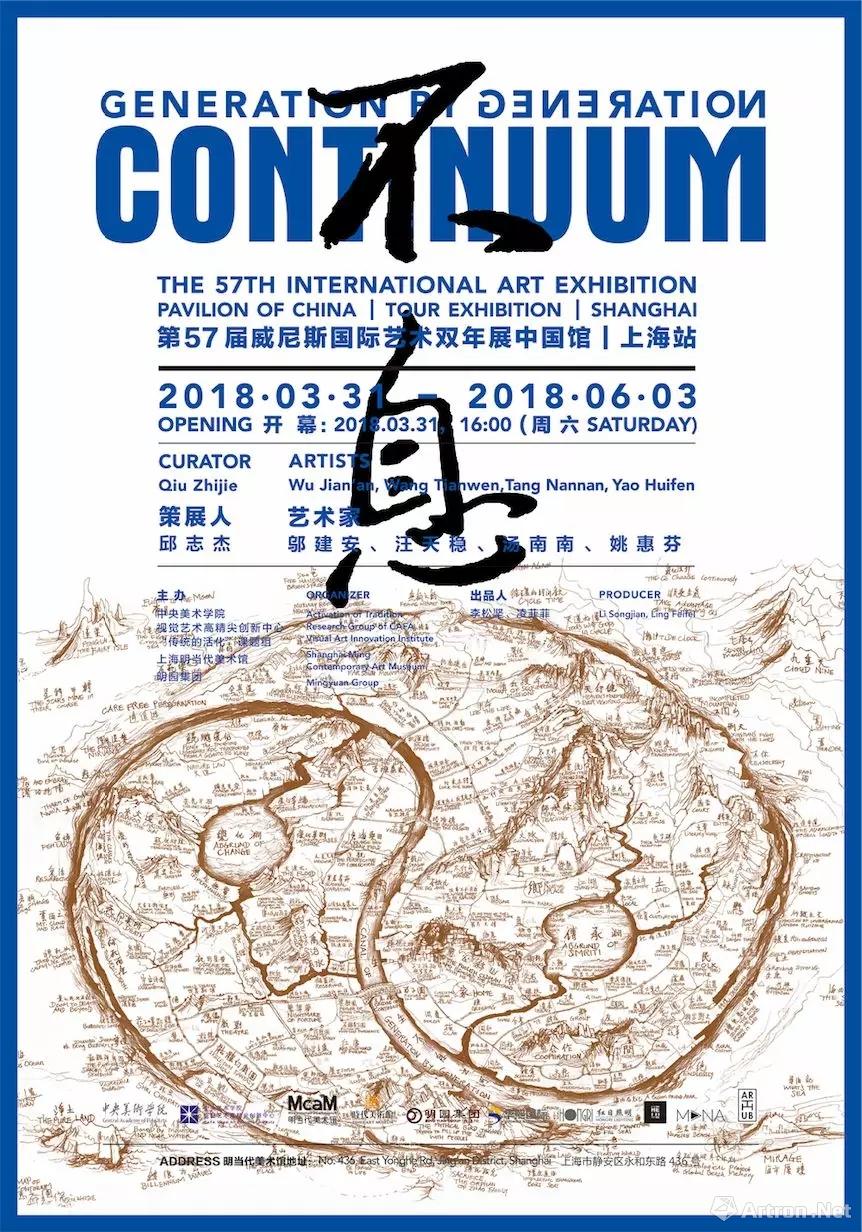
2017年第57届威尼斯双年展中国馆,由中央美术学院实验艺术学院院长、艺术家邱志杰策划,邬建安、汤南南、姚惠芬和汪天稳为参展艺术家。其中姚惠芬为苏绣大师,汪天稳为皮影雕刻大师。展览展出了多件录像、绘画、雕塑、装置、刺绣、皮影、摄影乃至多媒体剧场等丰富的作品,并以丰富的文献和工作坊、演出成为重要特征。展览以“不息”应对整个威尼斯双年展的总主题“艺术永生”,提出中国艺术“不息”的力量来自精英与民间的互动,来自代际传递的师承,来自积极的合作。展厅中独一无二的艺术家师承墙、艺术家合作关系图,多位艺术家的交叉合作,以及由程控机械、实时VJ操纵的投影、陕西民间艺人与青年艺术家合作创作的多媒体皮影表演,成为亮点。
2017年威尼斯双年展中国馆《不息》,在国际当代艺术世界引发了广泛的关注。长达半年的展览期间,中国馆以其强烈的视觉冲击力,完整的策展理念,独特的语境构建,引发了热烈关注和广泛好评。尤其是开幕周期内的多媒体皮影演出,场场爆满,掌声雷动。展览受到了国际艺术媒体和专业人士的普遍好评。
而在威尼斯大获成功的2017年中国馆,在国内却引发了两极化的巨大争议。赞誉者认为极其出色,批评者认为丢人现眼。评价两极分化,激烈对立,在2017年初夏的中国艺术圈,尤其是互联网上引发了巨大的话语狂潮。争议集中在是否应该使用皮影和刺绣这样的非物质文化遗产去参加威尼斯双年展这样的“当代艺术”活动?中国馆对于皮影和刺绣这类传统工艺的运用是否误解“当代艺术”?是否存在中国独特的当代艺术方式?话题乃至延伸到了雅集、庙会式的策展实验与白盒子展示空间背后的意识形态对立;当代艺术是否需要现场经验?运用传统元素是文化投机还是文化自信?是否存在普世的“国际当代艺术”等等更深的层面。可以说,因为这些争论的存在,以及这些争论背后的价值观对立的存在,2017年威尼斯双年展中国馆,无疑已经成为当代中国艺术发展史上的重大事件,也将是当代文化史上,中国价值观和中国工作方式初步确立的一个里程碑式的事件。
展览作品在威尼斯经历半年展出,经过数月海运,日前回到国内。按原计划,将于2018年3月31日在上海明当代美术馆和北京时代美术馆同时推出《不息-第57届威尼斯双年展中国馆》的上海站和北京站的落地展。因为这两个美术馆的空间条件与威尼斯军械库油库展厅的空间有所不同,展览作品在基本不变的情况下略有调整,补充了因为威尼斯空间局限,部分艺术家当时未能展出的作品。展览的策展思路不变,而随着空间的变化和语境的变化,展览的气质与当时威尼斯的现场有所不同,但依然能在相当程度上让未曾造访威尼斯现场的观众们看到策展和作品的思路。我们相信,因为此前国内巨大争议的存在,发生在上海和北京的这次归国汇报展览,对于本次威尼斯双年展中国馆尤其具有价值。
此刻距2017年5月初威尼斯开幕已经过去10个月,中国艺术界应该有更年长一岁的成熟和理性,来反思我们的激烈的实验;应该有更大的自信,来赞美我们的艺术家所创造的不可思议。当代中国艺术的继续进步,有赖于整个艺术生态各个环节积极善意的建设性互动所构造的能量场。
不管来自民间还是学院,每一个中国艺术家,都不是一个人在创作。他的创作,总是一种应答和开启,总是在期待唱和,总是可以加批注和题跋。中国艺术绝不是任何一个生死有命的中国艺术家的个体创造,而是一场历时五千年的集体创作,这是一代代艺术家不断卷入的,一场跨越千年的唱和和雅集。本届中国馆向世界展示的当代中国艺术,是这场数千年的集体创造的新的生产。它正直坦荡,不是削尖脑袋猴急经营的创造力,而是脱胎换骨后的自然洋溢;不是暴烈的资本炒作的成功,而是感染和召唤所致的认同。它是一种基于中国文明的底色和基因,基于中国人的人情冷暖和匠心文运、通情达理的新的当代艺术。
The China Pavilion at the 57th Venice Biennale in 2017 was curated by Qiu Zhijie, artist and the Dean of School of Experimental Art of CAFA. The four participating artists in this project are Wu Jian'an, Tang Nannan, Yao Huifen, and Wang Tianwen. Among them Yao Huifen is a master of Suzhou embroidery, and Wang Tianwen is a shadow puppet master. Works including video art, painting, sculpture, installation, embroidery, shadow puppet, and multimedia theatre performance were shown in the exhibition, accompanied by a broad range of archives and workshops. The theme ‘Continuum – Generation by Generation' responds to the theme of this year's Venice Biennale, ‘Viva Arte Viva.' The source energy that powers the will to persevere, and makes possible the generational continuum, comes from the the constant interaction and inter-fertilization between the cultural elite and the folk, from generations of teachings past down from masters to their disciples, and from proactive collaborations. The highlights of the show include the unique wall of succession of teachings, collaboration diagram of the artists, the crossover collaborations among the artists, projections controlled by program-controlled mechanism and live VJ, and the shadow puppetry performance created by folk artists from Shaanxi and young artists together.
The exhibition of the China Pavilion at the 57th Venice Biennale in 2017, Continuum – Generation by Generation, gained attention from the international contemporary art world. Through out the half a year of exhibiting period, the China Pavilion received attention and wide praise with its strong visual impact, complete curatorial idea, and unique construction of context. The multimedia shadow puppetry performances during the opening period were especially applauded by the huge crowds gathered during each performance. The exhibition was generally praised by international art media and art professionals.
The 2017 China Pavilion was hugely successful in Venice, however, the debate about the Pavilion of China is so unprecedentedly fierce at home, the opinions are almost polarizing. People who praise the show thought of it as outstanding, the critics thought of it as a disgrace – the reactions of the show were polarizing and of fierce opposition. In early summer of 2017, a huge wave of discussions and debates happened in the Chinese art circle, especially on the Internet. The debates focused on whether we should showcase intangible cultural heritage such as shadow puppetry and embroidery in "contemporary art" activities such as the Venice Biennale. Is using traditional crafts such as shadow puppetry and embroidery in the China Pavilion a misunderstanding of "contemporary art?" Does a unique way of Chinese contemporary art exist? The debate topics even expanded to deeper aspects such as the ideological opposition behind the experiments of the curatorial model of yaji and temple fair vs. the white cube exhibitional space; Does contemporary art require onsite experience? Is using traditional elements cultural speculation or cultural confidence? Does a universal "international contemporary art" exist? We can even say that because of the debates and the polarizing values behind them, undoubtedly, the 2017 China Pavilion has become a major event in the history of the development of contemporary Chinese art. It will also be a landmark event in the history of contemporary culture in terms of the initial establishment of in China‘s values and the Chinese working methodology.
The exhibition in Venice lasted half a year, then it took several months to be shipped back to China by sea. As planned before, the tour exhibition of China Pavilion at the 57th Venice Biennale Continuum – Generation by Generation, will open simultaneously at Shanghai Ming Contemporary Art Museum and Beijing Times Art Museum on March 31st, 2018. Given the different conditions of the space of the two museums from the rusty and industrial space of the Arsenal in Venice, we made some small adjustments of the works, and added works unseen before given the limitations of the Venice space. The curatorial idea remains the same, but with changing space and context, the exhibition will have different qualities from the one in Venice. However, audience who did not had the chance to see the show onsite in Venice can still appreciate the works and curatorial theme to a large degree. We believe that due to the fierce debate in China about the China Pavilion before, the returned tour exhibitions in Shanghai and Beijing became more valuable to the China Pavilion in Venice in 2017.
It has been ten months since the opening in early May 2017 in Venice, the Chinese art circle should be more mature and rational with more time to reflect on our bold experiments; we should have greater confidence to praise the unprecedented creations made by our artists. The continued progression of the Contemporary Chinese art depends on the energy field constructed by the proactive, positive, and constructive interaction of each link of the whole art ecosystem.
Each Chinese artist, no matter folk or academic, is not working in solitude. His or her creation is always a kind of response, an opening up of a new trajectory, an anticipation of an antiphon, a commentary, a coda: an act of creation in a communal context. Chinese art is never an individual creation by a mortal Chinese artist, it is a communal act across five thousand years of our collective history, in which each artist both participates and responds: a kind of cross-generational yaji gathering. This year's China Pavilion showcased the contemporary Chinese art to the world, it is a new production of the collective creation that spans across thousands of years. It is with great integrity, not wheeling and dealing for fast gains, but flowing freely after being reborn; it is not success through vicious capital speculation, but gaining recognition through influence and beckoning. It is a kind of all-encompassing new contemporary art that based on the backdrop of Chinese civilization, human relationship, inventive craftsmanship, and literary tradition.